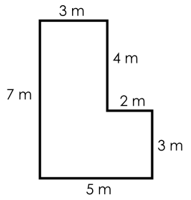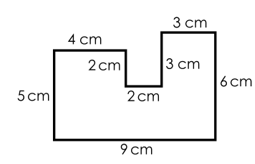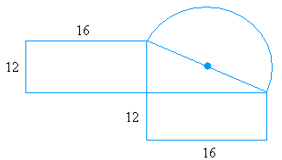These worksheets provide lessons, practice problems for various skill levels, review sheets, and quizzes to help your students learn how to calculate the area of an irregular shape. Each entry offers a series of unique shapes and geometric figures. Please make note that because many of the shapes we use are larger the worksheets spread over multiple pages. In most cases we would advise you to review altitude of triangles with students before you start working on this section. Remind them of the use of vertex geometry when tackling these problems. As you move further down this page you will be confronted with irregular shapes on a coordinate grid.
Print Area of Irregular Shapes Worksheets
Click the buttons to print each worksheet and associated answer key.

Area of Irregular Shapes Lesson
Learn how to find the area of a figure based on the dimensions given. You will be walked through the entire process of breaking apart 2 triangles and a rectangle that are considered a whole.

Practice Problem Worksheet
For each, find the area of the figure shown. All of the measures are based off of standard rectangles and a series of triangles. So it would be good to review the measures for those specific geometric shapes.

Worksheet 1, Page 1
For each problem find the area of the series of figures that are shown. These problems take up a good deal of page space, this is the first page with 6 problems.



Worksheet 2, Part 2
This is the 2nd page to the previous worksheet. There are actually more problems on this page. Finish this one up strong!

Homework Review Sheet
Review how to find the area of a figure based on the given dimensions. This is helpful to send home with students.


Quiz Part 1
Time for a slightly formal assessment for your students. This quiz is 2 pages long. This part has the first 6 questions.


Do Now
Find the area of the figures shown. This can also be used as a warm or review sheet. It can serve many different purposes.

Area of Compound Shapes Lesson
Find the area of the compound shape. The figure can be divided into three parts, 1, 2 and 3 as shown in the figure. You can also use the coordinate grid points as a reference.

Drawing Compound Shapes
Draw a right triangle whose two perpendicular sides are given below, and then find its area.

Compound Shapes on Coordinate Planes
Find the area of these compound shapes by using the grid to pinpoint locations and differences in corners.

Drawing Area of Compound Shapes
Draw right triangles whose two perpendicular sides are given below and then find the area.

Practice with Compound Shapes
Lots of fun shapes for you to practice on. They differ greatly in size and scope.

Drawing Compound Shapes Warm Up
You will read the instructions to determine the geometric shapes and lengths of sides. This is great practice for when you decide to build something.

Basic Skills Independent Practice Worksheet 1
Find the area of these 10 irregular shapes and use the diagrams to help you solve these problems.

Independent Practice Worksheet 2
What's the area of those shapes? Make to pay attention to the diagrams and measures that are all set up.

Intermediate Skills Practice 1
These types of problems are a little more involved here. You need to break things down into segments to properly get all their measures.

Intermediate: Independent Practice 2
Time for more work on this topic for you. We would recommend reviewing all the different geometric shapes present before you attempt this worksheet.

Intermediate Skills Worksheet 3
The irregular shapes are really varied here. We would recommend that survey everything before trying to solve these problems.

Advanced Irregular Shapes Lesson
Follow the steps to practice identifying the regular shapes within the irregular shape shown, then find the total area. You will break everything down and then add it all up at the end.

Advanced Homework Worksheet
A full walk through is provided and then two problems for you to do on your own. This is perfect for students that may have missed a lesson or extra support for homework.


Advanced Practice Worksheet
Make sure to read everything clearly and handsomely. There are 10 more advanced problems for you to solve here.

Show the Skill
We would suggest breaking apart all the spaces and plan how to answer each problem before jumping into the math.

How to Find the Area of Irregular Shapes
If you have recently learned how to tackle areas and volumes of shapes and are wondering what you would do if you came across an irregular shape in your exam, we are here to help. These are the shapes that do not fit into a particular category of geometric shape, but rather is composed of a mixture of them in mixed order.
The area of irregular shapes is found by measuring and calculating any space covered by a shape. The answer is derived in square units, in most of the situations that you will come across. These unique shapes can include multiple shapes within their area, which is exactly what we use when determining the surface area they cover.
Having the able to caluculate this value is important since we find irregular shapes all around us. The clouds, our cars, the trees, and the leaves; anything that does not contain sides of equal length can be an irregular shape! When you become a homeowner or begin to construct any type of structure that you have at, this math will be super important. You need your calculations to be accurate to save yourself time and money. You will use these measure to determine how much material to buy and order.
What is Area?
An area can be simply explained by placing a 2D shape on a surface. Any area that the shape covers is its surface area. The area becomes much easier to calculate if the shape is placed on a grid. However, most irregular shapes do not come with grids.
Put It to Work
The trick is to divide the shape into different, smaller shapes. The cars that we drive are divided into shapes of equal length. The car as a whole is an irregular shape, made up of many regular shapes.
Similarly, a baseball field, basketball court, classroom, or bedroom consists of irregular shapes. All you need to do is to look around!
Tip: Always remember to add m2 or cm2 to your surface area calculations. You can infer that each square of the coordinate grid is one square unit. Use each of the worksheets to work on how to determine the area of various irregular shapes using the information provided about the length of their sides, angles, etc. (formulas have been provided). Compound shapes are usually made up of several basic shapes. In this manner you can break the structure up into several pieces. When you determine the area of those individual shapes, you just add or sum all of these up and you are good to go.

This shape is irregular, and its area cannot be determined using a specific formula. However, we can see that it consists of six sides and can be split into two rectangles!
When these two rectangles merg, we can get the square area of the irregular shape, even if we don't have the formula to derive it directly.
First, calculate the surface area of rectangle 1: 5 x 3 = 15
Then, calculate the surface area of rectangle 2: 4 x 3 = 12
Finally, add them up: 15 + 12 = 27m2
This is the surface area of your irregular shape!
Let's work with a more complicated example:

This shape is split into three rectangles. The trick is to first calculate the length and width of all the rectangles.
Rectangle 1: This rectangle is 5 cm tall and 4 cm wide.
Rectangle 2: This rectangle is evidently 2 cm wide. However, its length is a little complicated. The way to determine it is to take away 3 cm from 6 cm (notice the length above) to reach 3 cm.
Rectangle 3: This rectangle is 6 cm high and 3 cm wide.
Now find all the areas:
Rectangle 1: 5 x 4 = 20
Rectangle 2: 2 x 3 = 6
Rectangle 3: 6 x 3 = 18
Total Area: 20 + 6 + 18 = 44
Formula of Area of Regular Shapes
There's no one formula you can follow to determine the area of regular shapes. However, we can map out an easy formula that applies to every irregular shape.
Find all areas of the regular shapes and sum the total areas. Here's a final example that can clear it for you.

This irregular shape contains 4 regular shapes.
The formula is: (Area 1) + (Area 2) + (Area 3) + (Area 4) = Total Area
Area 1= Rectangle 1
16 x 12 = 192 cm2
Area 2 = Rectangle 2
16 x 12 = 192 cm2
Area 3 = Triange 1
½ x 16 x 12 = 96
Area 4 = Circle 1
pi x 202 = 400pi
Total Area = 192 + 192 + 96 + 400pi = 480 + 400pi
Final Thoughts
You must be wondering how we calculated the radius of the circle. That is done through a popular concept known as the Pythagoras’ Theorum. However, that is just food for thought, or perhaps a topic for the next lesson.
For now, remember that the answer "how to find the area of irregular shapes" is divide and conquer!


